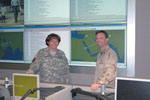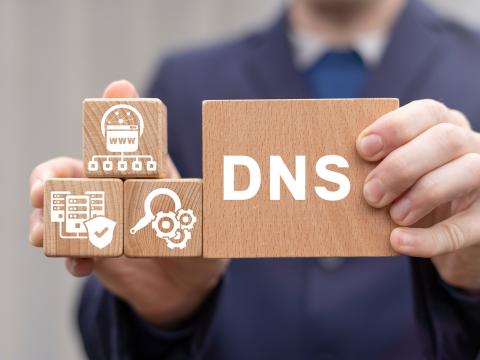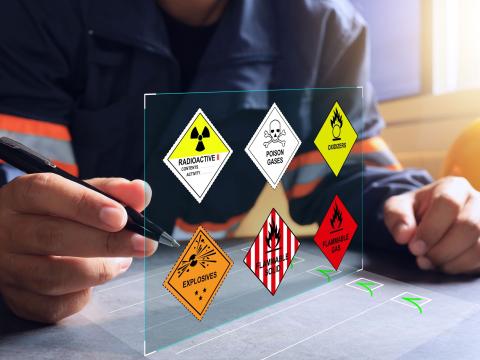CENTCOM Pursues Assured, Interoperable Communications
 |
| Brig. Gen. Susan S. Lawrence, director, command, control, communications and computers, J-6, U.S. Central Command (CENTCOM), and Maj. Craig A. Fleming, USAF, J-6 executive officer, review information during a visit to the 25-member Network Operations Center at CENTCOM. The general receives daily updates here on the status of the communication systems. |
The U.S. Central Command faces an array of technological and procedural problems in the area of command, control, communications and computers. From a need to include interagency and coalition partners on networks that do not support their access to information to a requirement to update communications infrastructures that are primitive, nonexistent or targeted by the enemy, creating network centricity that fully supports the troops is a constant challenge for the command.
In an effort to improve communications in the Central Command’s area of responsibility (AOR), leaders from the command and around the
Brig. Gen. Susan S. Lawrence,
According to the general, storing the necessary information in the correct format and then sharing that information with the right people are essential to network centricity. Unlike past operations, commanders no longer suffer from a lack of information, but instead from an excess of data that users must sift through before making decisions. The military is working to adapt to this new reality and is developing networks to support it.
For example, in
Recently, CENTCOM personnel partnered with the Defense Information Systems Agency (DISA),
“If we think our next strategic threat is coming from this theater, why don’t we put that enduring C4 infrastructure in place and then extend from there?” she asks. “And put that IP technology in there? And increase our terrestrial fiber links and those kinds of things that enable our ability to get to the network-centric environment that we’re trying to achieve?” This type of planning can posture the military for the next five to 10 years and improve situations for the next troops rotating into the battlefield, she adds.
Gen. Lawrence says she has briefed C4 leadership on these ideas and they are looking at moving forward with plans, but creating that sort of network-centric environment will require universal standards and protocols that allow interoperability among the military, governmental partners and coalition partners. The general cites the
“That happens frequently in our theaters and in the other theaters as well,” Gen. Lawrence explains. “So that’s what ‘network centric’ means to me—to be able to shift quickly from this tactical environment to this strategic and global need to command and control, and our being the enablers to do that.”
 |
Combat control pararescuemen and officers perform operational readiness checks on their equipment before deploying to an undisclosed location in support of operation Iraqi Freedom. U.S. Air Force photograph by Staff Sgt. Quinton T. Burris, USAF. |
Gen. Lawrence adds that factors other than technology create problems for establishing the network-centric environment she envisions. She says industry has moved the military forward quickly in terms of technology, but it may be causing the military to move backward in terms of interoperability because tactics, techniques and procedures lag behind technological advancement. “Just as soon as I think I’ve got my arms around something on the battlefield like IP, this new thing comes along like wireless,” she states. She continues that the military has to transition from an IP network to a wireless world and tie everything together in the system end to end.
These rapid developments further convince Gen. Lawrence of the need for standards and protocols, and she explains the need for a joint management approach and a configuration management approach to those protocols. “We’ve got to go back and bring some discipline, I think, into our process because we have an overloaded spectrum management issue that is so key to the battlefield right now,” she shares.
The general also is concerned with the C4 training courses offered by the military. She is looking to revamp C4 planners courses, trying to focus the classes on battlefield realities, not theories.
To make the network-centric environment she envisages a reality, the general says the emphasis during planning and development has to be on the warfighter. Instead of working on a C4 requirement in a “big picture” scenario first and pushing it down the pipe, decisions should be made at the lowest level. “We have to start at the first tactical mile and then develop the architecture back to the Beltway, instead of the other way around,” Gen. Lawrence says.
Collaboration and network tools alone do not satisfy the needs of the warfighter. The focus must be the troops in theatre. DISA just selected a collaboration tool for the next-generation collaborative services that meets many of the military’s needs, but it does not help Gen. Lawrence’s troops in the field. “I’m sure it’s a very powerful program, but it will not support that soldier sitting on that team, planning the operations in
Part of the key to giving the warfighter the needed capabilities is preparing for the future—and that means posturing troops and networks for a long war. Gen. Lawrence and her partners and counterparts are looking for redundancies that they can eliminate in the systems, providing tools for better multilevel security guards, searching for better cross-domain solutions and delivering tools to the field that deal with the challenge of spectrum interference.
The general also wants joint tools to help secure networks. “Our networks are so absolutely critical to the warfigther that when he or she is in the middle of an operation and loses access to the network it impacts how we execute,” she says. “Protection of our networks has to become our number one priority because they are centers of gravity.”
For example, if CENTCOM were to lose the secret Internet protocol router network (SIPRNET), it would affect how leaders command and control. Not only would the exchange of data be lost, but voice over Internet protocol capabilities and VTC capabilities also would be gone.
Gen. Lawrence is focusing on research and development, especially in military satellite programs. She wants to see speeded up satellite programs and she wants a more robust military satellite network. In addition, the general wants to continue to develop networks that support the flexibility of adding more nongovernmental, interagency and coalition partners. Many of the entities that CENTCOM personnel work with every day—such as the Afghan National Army, Iraqi security forces and NATO—do not operate on U.S. networks. As the
In addition to challenges such as developing systems that allow all relevant parties access, CENTCOM has to find ways to work with countries that do not have the technical capabilities—or the resources to obtain those capabilities—that the U.S. military and government have. When the general met with her counterpart in the Afghan National Army to discuss the way ahead for the tactical network and communications between their forces, he told her his C4 budget for the next year was $25,000. “I say, ‘Guys, start at the first tactical mile and work your way back.’ Well, in my theater, I have to start at the lowest denominator and work my way back,” Gen. Lawrence explains.
To remedy these types of issues, Gen. Lawrence stresses the need for systems that can accommodate users from other agencies and countries. She wants a rule-based, Web-based and network-based solution. “Don’t give me another box to figure out how I’m going to have the Iraqi security forces get the information they need,” she states.
Gen. Lawrence is reaching out to the private sector to help meet her network needs, and she has several requests and directives for industry partners. “I challenge industry [officials] whenever I speak with them to come up with enterprising protocols and solutions that are interoperable,” she says. She reminds industry to keep in mind everyone who needs to communicate over the systems they design, reiterating that
Gen. Lawrence also wants industry to help find solutions to the problem of spectrum availability. “The company that builds a radio that is not already in the oversaturated area of our spectrum is going to be a very popular company,” she states.
When industry develops systems, the general also encourages it to consider that the CENTCOM theater has little to no local C4 infrastructure and that insurgents target
Finally, she asks that when companies develop products such as radios, servers and modems that they do not test them over fiber. Products tested in the
“Remember that soldier who’s in the mountains of
Web Resources
Defense Information Systems Agency: www.disa.mil
Joint Chiefs of Staff: www.jcs.mil




Comments